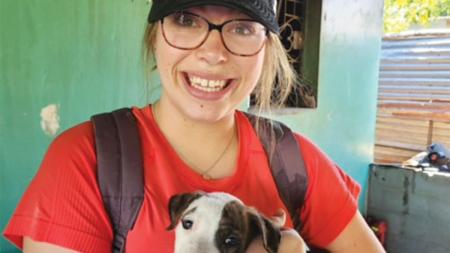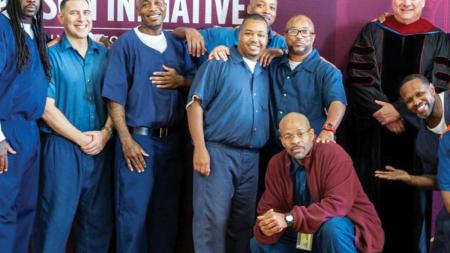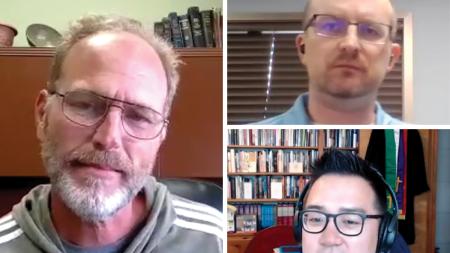Documentarian Turns Her Lens on Teen Homelessness

Kirsten Kelly grew up some 80 miles northwest of Calvin College’s campus in Oceana County, the daughter of a farmer in the self-proclaimed Asparagus Capital of the World.
So it made sense that after graduating from Calvin with a communications arts and sciences degree, and after doing theater and directing in Chicago, and after graduation from the Juilliard School of Directing, that her first documentary film was the aptly named Asparagus! (Stalking the American Life).
Indeed it was the first film and a fitting one from her Spargel Productions (spargel is German for asparagus), a venture she co-founded with fellow Asparagus! producer Anne de Mare. But Spargel’s next project took Kelly and de Mare a long way from the asparagus fields.
This project, a documentary film called The Homestretch, follows three homeless teens in their struggle to stay in school, graduate and build a life.
The 90-minute documentary is slated for release April 13, 2015, on the PBS Independent Lens program. It’s an unvarnished glimpse into the lives of the homeless and the heroes who daily work to help them, and it’s already getting the attention of public school administrators, federal agencies and others around the country.
A Labor of Love
The film was a labor of love for both Kelly and de Mare, who spent five years on the project from start to finish, seeking and earning a variety of foundation grants along the way in order to fully fund the film and bring it to completion.
There were many times when it was challenging work, Kelly admitted, on a devastating subject to film. But the Oceana County farm girl comes from sturdy stock, and the kids inspired her, so she didn’t just get through the project, she cultivated its flourishing.
“I’ve always been grateful,” she recalled, “that growing up on the farm taught me how to be scrappy. And it taught me that getting your hands dirty and working long hours is important to get the harvest done.”
Kelly also believes that her upbringing was a gender bender.
“I never felt a difference between what a boy could do and what a girl could do,” she said. “We were brought up to just do it. We had two girls in my family, and we were working summers starting from 5 years old, driving forklifts by 9, and in general helping to fix things, change the oil, running crews on the field. I was always grateful for that, too.”
Life Lessons
The life lessons learned on the farm came in handy on the asparagus documentary as she returned to her home turf to tell the tale of not just the people struggling to survive on the family farm, but also the geopolitical ripples that in the 1990s turned Peru into a major exporter of asparagus, threatening all manner of U.S. production.
Those life lessons continued to serve her well as she worked on The Homestretch.
“I think I am able to jump into a project and see how to move forward by taking small steps,” she said. “And I don’t have to know exactly how to do it, but can move forward and figure it out.”
Like the asparagus documentary, The Homestretch has its roots in experiences Kelly witnessed firsthand. As a Calvin student she did a semester-long internship program in Chicago at Chicago Shakespeare Theater. She then returned to Chicago, and Chicago Shakespeare, after graduation and, among other things, started a program for students in Chicago Public Schools (CPS) called “CPS Shakespeare!”
Each year, CPS Shakespeare! brings CPS high school students and their teachers to the theater for a five-week process that culminates in two performances on Chicago Shakespeare’s main stage.
That program has been a smash success in the Chicago area. So much so, in fact, that in November 2014, at an official White House ceremony, first lady Michelle Obama awarded CPS Shakespeare! the prestigious National Arts and Humanities Youth Program Award, the nation’s highest honor for after-school creative youth development initiatives from the President’s Committee on the Arts and the Humanities.
A Face on the Homeless
But the program also opened Kelly’s eyes to the problems of youth homelessness. One of her participants was such a youth. And as Kelly got to know him she realized that many of her misconceptions about homeless youth were way off base.
“It was one of those moments in life when everything just stopped,” she recalled. “How could this be? This kid was bright, talented, funny and ambitious. He was going to school, attending rehearsals and seemed so normal. But each night he didn’t know where he was going to go. He was working hard to make something happen for himself while being alone in an impossible situation, and he was going to great lengths to hide his circumstances. For us, he put a completely unexpected face on homeless youth.”
His story forced Kelly and her film partner to dig deeper into understanding the truly staggering nature of youth homelessness.
In Chicago alone it’s estimated that as many as 22,000 public school students are homeless at any given time. Across the country the number might be more than a million.
For Kelly it became a crisis that nobody was talking about, a crisis that she hopes her film can help address and fix.
In 2009 Kelly and de Mare began to work, talking to teachers and principals, spending time with homeless kids at school, riding the trains and buses, in emergency youth shelters and more.
And, Kelly said, each one of the many kids they talked with had an enormous effect on the film.
“But,” she added, “when we found Kasey, and then Anthony, and then Roque, we were blown away by their powerful journeys and knew we had found the center of our film. It is our hope that, through the deeply personal journeys of Kasey, Anthony and Roque, the film can shine a much-needed light on one of the most hidden and exploited populations in America: unaccompanied homeless youth.”
Kelly knows that her film can’t solve the problem of homelessness. But she is hopeful that it can “spark an intensive, inspiring dialogue about how we, as a society, are addressing this complex problem and how we can do better.”


